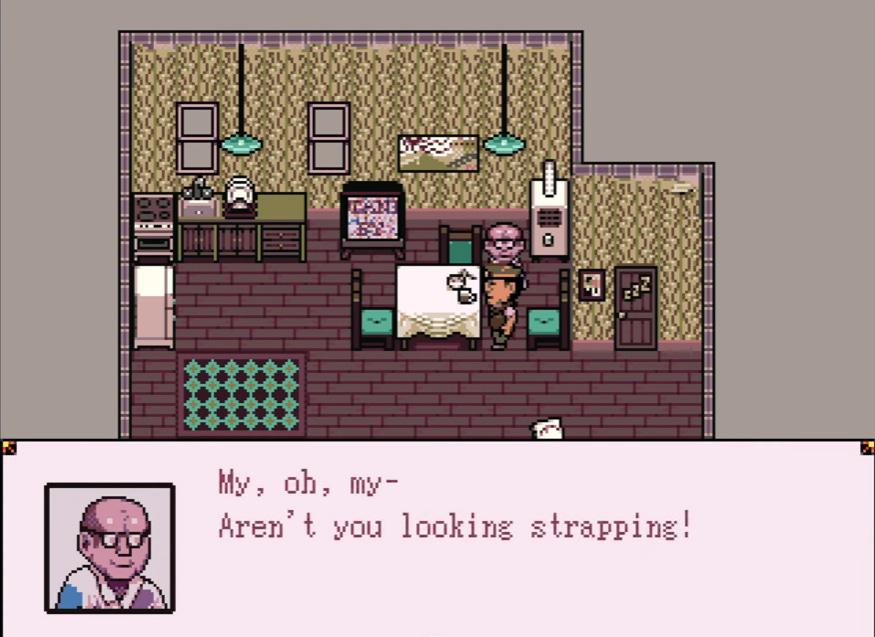There Swings a Skull: Grim Tidings (2022): Embers of Love
Writing What I Didn’t Know in There Swings a Skull: Grim Tidings
By Conor Walsh (Twitter / Bluesky)
There Swings a Skull: Grim Tidings is the project I am proudest to have worked on. A narrative-horror, climate apocalypse game culminating in live immolations, it is grounded by the loving relationship at its core between middle-aged wageman Anatoli and his artist husband Pyotr.

This relationship is a loving marriage between two men in their autumn years. The writer of this relationship was a single twenty-three-year-old straight boy who hardly had a concept of autumn years. Yet the bond between the two leads offers a welcome respite from the suffocatingly bleak atmosphere of TSAS, and is something I believe works remarkably well. Our players agree. I consider this praise a point of pride, but my approach to the husbands’ relationship wasn’t unusual: they act like any two people in love would. As I came to understand the two characters,their natural chemistry evolved, and I found that the game nearly wrote itself.
Some backstory about how the couple came to be: during our initial brainstorming for TSAS, my co-dev Quinn K. (art, design, co-writing, scripting, general morale boosting) suggested that Anatoli be “quietly, but not closeted, gay”. Our other dev, Leaf Let (music and audio wizardry) and I concurred, but the idea developed further — instead of Anatoli’s sexuality serving as an aspect of his quiet, siloed world, we chose to do the opposite, creating Pyotr to act as Anatoli’s motivator and counterpart. Pyotr is more withdrawn and aloof, but prone to bouts of strong emotion and activity; Anatoli is reliable and hard-working, but has difficulty in deviating from the well-worn path. Anatoli supports Pyotr’s art, Pyotr supports Anatoli’s occupation and future plans; each is the reason the other gets out of bed in the morning.
Not everything is easy for the couple. They fight, yes, they handle the looming catastrophe facing Pareildas in two vastly opposite ways. There are moments of strain. But through it all I tried to make sure that it was abundantly clear these two cared deeply for one another. Pyotr flirts with Anatoli in well-tread, predictable ways, but Anatoli turns beet red every time regardless. For Anatoli’s part, I sought to make it clear that everything he does, he does for Pyotr.

Amid their moments of drama and conflict, I felt it very important to make sure there was no major point where Anatoli or Pyotr’s sexuality was a point of drama. In addition to this not being what the game was about, I do not have the lived experience of being gay; I felt any attempt by me to portray the greater complexities of the identity ran the risk of being cloying or melodramatic at best. This mistake is all too easy to make as a straight writer when it comes to gay characters, and one I took great care to avoid. There’s plenty of angst and misery in TSAS; I didn’t feel it necessary for it to stem from within Pyotr and Anatoli’s relationships or senses of self.
One of the most important parts of writing these characters was running them by my co-devs, who are members of the LGBTQ+ community, to make sure I wasn’t wildly off-base. I’m a firm believer in not writing what you know, as otherwise every game I made would be about staying inside for days straight playing nothing but Grim Dawn (that’s out the window until I figure out how to program loot tables), and I certainly wouldn’t be writing any gay characters. Thankfully, with Leaf and Quinn helping to tone-check everything I wrote, I could approach Pyotr and Anatoli’s relationship with the confidence to make it as genuine as I could — mid-marriage sexual innuendos included!
We decided to change the game’s ending very late in development. This decision is the only one in the game I can think of that was partially influenced by the nature of Pyotr and Anatoli’s relationship. Originally, the sequence where the couple’s apartment burns was the end of the game, and a fittingly bleak one. However, we realized that, by doing so, we were playing into the “bury your gays” trope which sees LGBT+ characters dying at a greater frequency (often more horribly) than their heterosexual counterparts in media. We discussed it, and decided to change what we had to make the ending more hopeful and ambiguous. I’m glad we did, as I believe the old ending would have betrayed the thematic core of the game — that in the face of overwhelming existential dread, one must love all the harder.
No other project I’ve worked on has had me combing Twitter/Bluesky/Myspace/the graffiti behind the dumpsters for any mention of the game as often as TSAS has, and Pyotr and Anatoli are the seed from which the rest of the game grew. I’m proud of the work I did, but more proud of the work our team accomplished together; the three of us created something we’d never have been able to do alone.
And I’m most glad I was able to bring these two together.
Post-script
Thanks for reading!
Q: What is a game you’d like to make, if given the chance?
A: I think it would be neat to make a survival horror game set in an abandoned, half-frozen mountain town some day. The idea is loosely blocked out, but it’s probably years away from finding a slot in my schedule.
Q: What reference(s) were useful to your game?
A: I always recommend everyone play Pathologic 2, as the town’s descent into chaos as well as the atmosphere of looming dread were fitting inspirations for TSAS. I also recommend reading any novel or short story by Ray Bradbury if you seek to encapsulate true beauty in your works.










